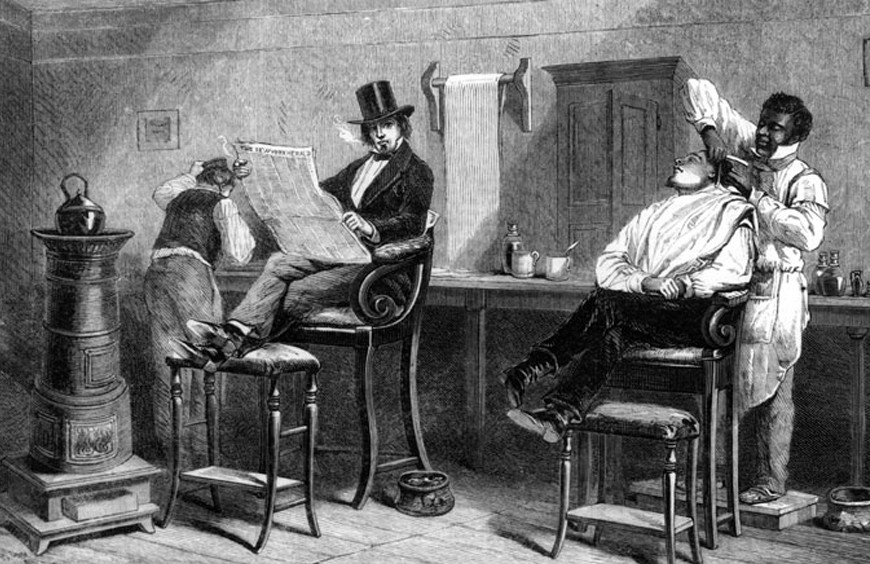
Barbering is one of the oldest professions, with its history deeply intertwined with social and cultural evolution. Over thousands of years, barbering tools and practices have evolved from crude implements to sophisticated devices that reflect technological advancements and society’s ever-changing notions of beauty and grooming. This journey from the Stone Age to the modern era highlights the enduring significance of the history of barbering and its impact on society.
The Stone Age: The Dawn of Grooming
Barbering can trace its origins back to prehistoric times when early humans sought to maintain their hair and beards for practicality and aesthetics. During the Stone Age, rudimentary tools such as sharpened flint, obsidian, and seashells were used for cutting and shaving. These early implements were primitive but effective, meeting the basic need for grooming and hygiene in a survival-dominated world.
In these early societies, grooming was more than a personal choice; it was often a spiritual or ritualistic act. Hair and beards were sometimes trimmed as part of ceremonies or to denote status within the tribe.
Ancient Civilisations: Barbering as a Social and Spiritual Practice
As civilisations advanced, so did the art of barbering. In ancient Egypt, barbering was respected, with barbers often serving the elite and clergy. Bronze razors were crafted with precision, enabling more refined grooming practices. For Egyptians, grooming symbolised cleanliness and order, values closely tied to their spiritual beliefs.
Barbering flourished as a communal activity in Mesopotamia, Greece, and Rome. Greek barbershops became hubs of social interaction, where men gathered to discuss politics, philosophy, and daily affairs. The tools of the time included razors, shears, and combs, often crafted from metal or bone. Roman barbers, known as “tonsors,” expanded their roles to include dentistry and minor surgeries, further elevating their status in society.
The Middle Ages: The Barber-Surgeon Era
During the Middle Ages, barbering played a dual role as barbers became “barber-surgeons,” performing medical procedures alongside grooming. Their tools included razors, scissors, lancets, and cupping glasses for bloodletting. This period also led to the iconic barber pole, with its red and white stripes symbolising blood and bandages.
Barbershops during this era were practical spaces, but the tools used remained relatively rudimentary. Scissors evolved into more sophisticated designs, and straight razors with folding blades began to emerge. However, the overlap between barbering and medical practices meant that hygiene standards often lagged behind, leading to calls for greater specialisation in the later centuries.

The Renaissance and Early Modern Period: Refinement and Specialisation
The Renaissance ushered in a renewed focus on personal grooming and aesthetics. Barbers became highly skilled craftsmen, and their tools reflected this artistry. Straight razors with ornate handles, often made from ivory or wood, became standard. Combs, brushes, and scissors were crafted with greater precision, enabling barbers to achieve intricate styles.
This period also marked the professionalisation of barbering, with guilds and training programs standardising practices. Barbershops became more elegant and specialised, reflecting the growing importance of personal appearance in Renaissance culture.
The Industrial Revolution: Mechanisation and Accessibility
The 19th century brought revolutionary changes to barbering tools with the advent of mass production and new materials. Straight razors peaked in popularity, with manufacturers producing high-quality blades that were durable and easy to maintain with leather strops.
A major breakthrough came in 1880 with Frederick and Otto Kampfe’s invention of the safety razor. By incorporating a protective guard, this tool made shaving safer and more accessible. King C. Gillette’s refinement of the safety razor in the early 20th century, featuring disposable blades, transformed shaving into a convenient daily ritual for men worldwide.
The 20th Century: Electric Tools and Modern Barbering
The 20th century was defined by innovation in barbering tools. In 1919, Leo J. Wahl introduced the electric clipper, revolutionising hair cutting by providing speed and precision. These clippers became a staple in barbershops and remain indispensable today.
Other tools, such as electric razors, shears with stainless steel blades, and specialised thinning shears, became widespread. Barbers also began to use hairdryers and hot towel steamers, expanding their services to include hairstyling and relaxation treatments.
The mid-20th century saw a rise in personalised grooming, with tools designed for beard shaping, moustache styling, and facial care. Barbershops evolved into grooming and self-expression spaces catering to diverse styles and preferences.

The Modern Era: High-Tech Tools and Sustainability
Today, barbers rely on a blend of traditional techniques and cutting-edge technology. Cordless clippers and trimmers with adjustable settings offer unparalleled versatility, while laser-guided tools ensure precision in intricate designs. Heat styling tools, such as flat irons and curling wands, have expanded the range of hairstyles achievable in barbershops.
Sustainability has also become a key consideration in modern barbering. Eco-friendly materials, refillable products, and energy-efficient tools reflect a growing commitment to environmental responsibility.
The History of Barbering: A Timeless Craft
From sharpened stones to laser-guided trimmers, the history of barbering tools is a testament to human ingenuity and the enduring importance of personal grooming. Barbers have always been more than just stylists; they are artisans and community builders who use their tools to shape appearances and connections.
As the profession continues to evolve, the timeless art of barbering remains a reflection of society’s values, blending tradition with innovation to meet the needs of each generation.






